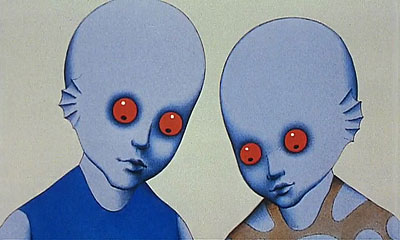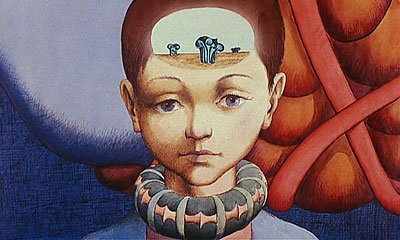Fantastic Planet: La Planète Sauvage
Published on May 30th, 2011 in: Cartoons, Climb Onto The Nearest Star, Culture Shock, Issues, Movies, Music, Science Fiction, Soundtracks and Scores |Like Rock & Rule , Fantastic Planet (1973) was an outstanding animated film introduced to me by USA’s Night Flight. For those who do not recognize this film by its English or French name (La Planète Sauvage), certainly you have seen images from it over the years; they aren’t ones you can easily forget.

Screencap by Eric Carl
La Planète Sauvage is one of the most visually and sonically arresting films I have ever experienced. For years, I only saw snippets on the above-mentioned Night Flight; when I finally saw the entire thing sometime in late 1989, it was like being transported back into the same aura of wonderment I felt in the early ’80s, watching it at 1 a.m. in the darkness of my living room.
The basic story is fairly simple: Two different races of creatures co-exist uneasily on the planet Ygam. One, the Traags, are the rulers; the other, the Oms, are kept as slaves and pets. The Traags are presented as having superior intelligence; they are also much larger in size. The Oms, on the other hand, are uneducated and considered savage by the Traags.
La Planète Sauvage includes a lot of information on Traag culture and science, which might seem like background information that does nothing more than provide the movie with the requisite sci-fi credentials, but it turns out to be quite important to the plot.
None of the jargon would be half as effective without the striking visual animation provided by artist Roland Topor and director René Laloux. The character design is fully realized, looking more like pencil sketches with a finely detailed stippling effect and not at all like traditional, Disney-style line-drawn animation. The color scheme of the film enhances the appearance of the characters as well.
The Traags are blue, hairless humanoids with red eyes and shell-like ears. They are vibrantly colored while the Oms, who look like human earthlings, are arrayed in mostly earth tones. Planet Ygam is filled with odd, yet organically-shaped constructions, flora, and fauna. Much of this is never explained or referred to, which heightens the sense of mystery and fascination.
At times, we are repulsed by the world shown on screen. Some plants generate crystals while others emit viscous fluid. They also make noises. There are several genuinely creepy critters shown throughout the film; the most disturbing is one with a face shaped like a lemon, and a long, multi-tentacled nose. It sits in a cage and waits for flying creatures to alight on its tentacles. Then, it violently shakes them until they fall to their death on the ground. It doesn’t eat them; it merely cackles in obvious delight.

Screencap by Eric Carl
To the Oms, who are after all much smaller than the Traags, this is a harsh, terrifying world. They are constantly on the lookout for various animals like a flying anteater/bat who sucks them out of their underground dwellings with a long tongue. Their biggest enemies, however, are the Traags themselves.
The film opens with a scene of an Om woman carrying a baby and running frantically away from what is revealed to be a Traag hand. We see the hand throw her to the ground with the flick of finger, not to wound or to kill, but simply for amusement. After picking up the Om and throwing her to the ground several times, she dies, leaving a crying baby.
We then realize that the Traags observing this action are children. One of them, Tiwa, decides to keep the baby as a pet. Eventually, it is revealed that this is a common practice among the Traags. It’s quite disturbing, as the film progresses, to see that not only do the Traags view the Oms as savage beasts, they don’t find anything wrong with treating them this way.
Since La Planète Sauvage is such a rich text, and so thoroughly engrossing, to reveal more of the story would be doing a grave disservice to anyone who has not yet seen the film. One can find many parallels between the civil rights struggles of people of color in a post-colonial world or the animal rights movement in the story of the Traags and Oms, and this, along with the distinctive look of the film, renders it as compelling now as it likely was in 1973, when it won the Palme d’Or at the Cannes Film Festival.
No discussion of La Planète Sauvage would be complete without reference to the exquisite sound design, including not only that of the otherworldly environment, but also the incredibly stunning, haunting score by Alain Goraguer. It perfectly conveys the bizarre alien world of the Traags and Oms with a mixture of vocalizations and sensual, spooky psychedelic music. Although the score is thoroughly enjoyable on its own, the movie could not exist without it.
La Planète Sauvage is available on DVD through Anchor Bay. The DVD includes a version with English language dubbing as well as the original French language version with English subtitles (the latter is the superior version). The book on which the film is based—Oms en série by Stephan Wul—was written in 1957. As of 2010 it is finally available in an English translation.
2 Responses to “Fantastic Planet: La Planète Sauvage”
December 5th, 2011 at 10:50 pm
[…] He was born in Chile in 1929 to Jewish Ukranian immigrant parents. Later, he lived in both Mexico and Paris, starting his own mime theater troupe and becoming immersed in the Panic Movement, a collective of performance artists inspired and influenced by Antonin Artaud and Luis Buñuel, and who included in their ranks Roland Topor, co-author of the screenplay for La Planète Sauvage. […]
December 5th, 2011 at 10:51 pm
[…] At present, Jodorowsky is 82 years old. With a life full of many artistic accomplishments, a description of them all is beyond the scope of an analysis of his films, but some introduction is needed in the hopes of illuminating how his background has informed his art. He was born in Chile in 1929 to Jewish Ukranian immigrant parents. Later, he lived in both Mexico and Paris, starting his own mime theater troupe and becoming immersed in the Panic Movement, a collective of performance artists inspired and influenced by Antonin Artaud and Luis Buñuel, and who included in their ranks Roland Topor, co-author of the screenplay for La Planète Sauvage. […]
Time limit is exhausted. Please reload the CAPTCHA.